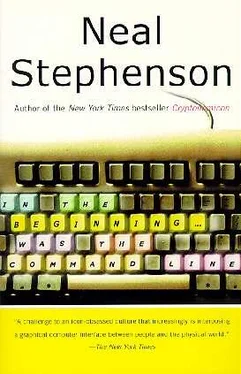Neal Stephenson - In the Beginning was the Command Line
Здесь есть возможность читать онлайн «Neal Stephenson - In the Beginning was the Command Line» весь текст электронной книги совершенно бесплатно (целиком полную версию без сокращений). В некоторых случаях можно слушать аудио, скачать через торрент в формате fb2 и присутствует краткое содержание. Жанр: Фантастика и фэнтези, на английском языке. Описание произведения, (предисловие) а так же отзывы посетителей доступны на портале библиотеки ЛибКат.
- Название:In the Beginning was the Command Line
- Автор:
- Жанр:
- Год:неизвестен
- ISBN:нет данных
- Рейтинг книги:5 / 5. Голосов: 1
-
Избранное:Добавить в избранное
- Отзывы:
-
Ваша оценка:
- 100
- 1
- 2
- 3
- 4
- 5
In the Beginning was the Command Line: краткое содержание, описание и аннотация
Предлагаем к чтению аннотацию, описание, краткое содержание или предисловие (зависит от того, что написал сам автор книги «In the Beginning was the Command Line»). Если вы не нашли необходимую информацию о книге — напишите в комментариях, мы постараемся отыскать её.
In the Beginning was the Command Line — читать онлайн бесплатно полную книгу (весь текст) целиком
Ниже представлен текст книги, разбитый по страницам. Система сохранения места последней прочитанной страницы, позволяет с удобством читать онлайн бесплатно книгу «In the Beginning was the Command Line», без необходимости каждый раз заново искать на чём Вы остановились. Поставьте закладку, и сможете в любой момент перейти на страницу, на которой закончили чтение.
Интервал:
Закладка:
As I've explained, selling OSes for money is a basically untenable position, and the only way Apple and Microsoft can get away with it is by pursuing technological advancements as aggressively as they can, and by getting people to believe in, and to pay for, a particular image: in the case of Apple, that of the creative free thinker, and in the case of Microsoft, that of the respectable techno-bourgeois. Just like Disney, they're making money from selling an interface, a magic mirror. It has to be polished and seamless or else the whole illusion is ruined and the business plan vanishes like a mirage.
Accordingly, it was the case until recently that the people who wrote manuals and created customer support websites for commercial OSes seemed to have been barred, by their employers' legal or PR departments, from admitting, even obliquely, that the software might contain bugs or that the interface might be suffering from the blinking twelve problem. They couldn't address users' actual difficulties. The manuals and websites were therefore useless, and caused even technically self-assured users to wonder whether they were going subtly insane.
When Apple engages in this sort of corporate behavior, one wants to believe that they are really trying their best. We all want to give Apple the benefit of the doubt, because mean old Bill Gates kicked the crap out of them, and because they have good PR. But when Microsoft does it, one almost cannot help becoming a paranoid conspiracist. Obviously they are hiding something from us! And yet they are so powerful! They are trying to drive us crazy!
This approach to dealing with one's customers was straight out of the Central European totalitarianism of the mid-Twentieth Century. The adjectives "Kafkaesque" and "Orwellian" come to mind. It couldn't last, any more than the Berlin Wall could, and so now Microsoft has a publicly available bug database. It's called something else, and it takes a while to find it, but it's there.
They have, in other words, adapted to the two-tiered Eloi/Morlock structure of technological society. If you're an Eloi you install Windows, follow the instructions, hope for the best, and dumbly suffer when it breaks. If you're a Morlock you go to the website, tell it that you are "advanced," find the bug database, and get the truth straight from some anonymous Microsoft engineer.
But once Microsoft has taken this step, it raises the question, once again, of whether there is any point to being in the OS business at all. Customers might be willing to pay $95 to report a problem to Microsoft if, in return, they get some advice that no other user is getting. This has the useful side effect of keeping the users alienated from one another, which helps maintain the illusion that bugs are rare aberrations. But once the results of those bug reports become openly available on the Microsoft website, everything changes. No one is going to cough up $95 to report a problem when chances are good that some other sucker will do it first, and that instructions on how to fix the bug will then show up, for free, on a public website. And as the size of the bug database grows, it eventually becomes an open admission, on Microsoft's part, that their OSes have just as many bugs as their competitors'. There is no shame in that; as I mentioned, Debian's bug database has logged 32,000 reports so far. But it puts Microsoft on an equal footing with the others and makes it a lot harder for their customers--who want to believe--to believe.
MEMENTO MORI
Once the Linux machine has finished spitting out its jargonic opening telegram, it prompts me to log in with a user name and a password. At this point the machine is still running the command line interface, with white letters on a black screen. There are no windows, menus, or buttons. It does not respond to the mouse; it doesn't even know that the mouse is there. It is still possible to run a lot of software at this point. Emacs, for example, exists in both a CLI and a GUI version (actually there are two GUI versions, reflecting some sort of doctrinal schism between Richard Stallman and some hackers who got fed up with him). The same is true of many other Unix programs. Many don't have a GUI at all, and many that do are capable of running from the command line.
Of course, since my computer only has one monitor screen, I can only see one command line, and so you might think that I could only interact with one program at a time. But if I hold down the Alt key and then hit the F2 function button at the top of my keyboard, I am presented with a fresh, blank, black screen with a login prompt at the top of it. I can log in here and start some other program, then hit Alt-F1 and go back to the first screen, which is still doing whatever it was when I left it. Or I can do Alt-F3 and log in to a third screen, or a fourth, or a fifth. On one of these screens I might be logged in as myself, on another as root (the system administrator), on yet another I might be logged on to some other computer over the Internet.
Each of these screens is called, in Unix-speak, a tty, which is an abbreviation for teletype. So when I use my Linux system in this way I am going right back to that small room at Ames High School where I first wrote code twenty-five years ago, except that a tty is quieter and faster than a teletype, and capable of running vastly superior software, such as emacs or the GNU development tools.
It is easy (easy by Unix, not Apple/Microsoft standards) to configure a Linux machine so that it will go directly into a GUI when you boot it up. This way, you never see a tty screen at all. I still have mine boot into the white-on-black teletype screen however, as a computational memento mori. It used to be fashionable for a writer to keep a human skull on his desk as a reminder that he was mortal, that all about him was vanity. The tty screen reminds me that the same thing is true of slick user interfaces.
The X Windows System, which is the GUI of Unix, has to be capable of running on hundreds of different video cards with different chipsets, amounts of onboard memory, and motherboard buses. Likewise, there are hundreds of different types of monitors on the new and used market, each with different specifications, and so there are probably upwards of a million different possible combinations of card and monitor. The only thing they all have in common is that they all work in VGA mode, which is the old command-line screen that you see for a few seconds when you launch Windows. So Linux always starts in VGA, with a teletype interface, because at first it has no idea what sort of hardware is attached to your computer. In order to get beyond the glass teletype and into the GUI, you have to tell Linux exactly what kinds of hardware you have. If you get it wrong, you'll get a blank screen at best, and at worst you might actually destroy your monitor by feeding it signals it can't handle.
When I started using Linux this had to be done by hand. I once spent the better part of a month trying to get an oddball monitor to work for me, and filled the better part of a composition book with increasingly desperate scrawled notes. Nowadays, most Linux distributions ship with a program that automatically scans the video card and self-configures the system, so getting X Windows up and running is nearly as easy as installing an Apple/Microsoft GUI. The crucial information goes into a file (an ASCII text file, naturally) called XF86Config, which is worth looking at even if your distribution creates it for you automatically. For most people it looks like meaningless cryptic incantations, which is the whole point of looking at it. An Apple/Microsoft system needs to have the same information in order to launch its GUI, but it's apt to be deeply hidden somewhere, and it's probably in a file that can't even be opened and read by a text editor. All of the important files that make Linux systems work are right out in the open. They are always ASCII text files, so you don't need special tools to read them. You can look at them any time you want, which is good, and you can mess them up and render your system totally dysfunctional, which is not so good.
Читать дальшеИнтервал:
Закладка:
Похожие книги на «In the Beginning was the Command Line»
Представляем Вашему вниманию похожие книги на «In the Beginning was the Command Line» списком для выбора. Мы отобрали схожую по названию и смыслу литературу в надежде предоставить читателям больше вариантов отыскать новые, интересные, ещё непрочитанные произведения.
Обсуждение, отзывы о книге «In the Beginning was the Command Line» и просто собственные мнения читателей. Оставьте ваши комментарии, напишите, что Вы думаете о произведении, его смысле или главных героях. Укажите что конкретно понравилось, а что нет, и почему Вы так считаете.








